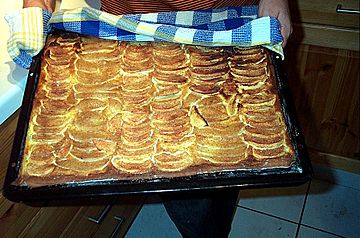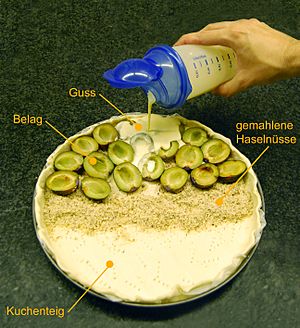Wähe facts for kids
A Wähe is a yummy baked dish that comes from Switzerland and parts of Germany. Think of it like a pie or a tart! It has a crust, usually made from shortcrust pastry (like a cookie crust), but sometimes it uses puff pastry or yeast dough. On top, there's a creamy filling called a custard that holds fruits, vegetables, or cheese. The filling and toppings are all baked together. It's very similar to a French quiche or tarte.
Contents
The Story of Wähe
The Wähe probably started in central Switzerland. The first time we see the word "wäye" written down was in 1556. Back then, it was described as a bun or cake.
The Wähe was first made at home. People used leftover dough from making bread. They would roll out these dough scraps into flat, round cakes. They'd push up the edges to stop the filling from spilling out. Then, they'd add whatever ingredients they had at home, like fruits or vegetables. This is why it's hard to separate the story of savoury (non-sweet) Wähen from sweet ones!
Over time, the Wähe became popular with everyone, not just as "poor man's food." In 1824, a cookbook called "The Cook Book of Catharina Fehr" even had a recipe for an "apple Dünne" (another name for Wähe). This recipe used butter pastry, sliced apples, and a sauce made from flour, wine, sugar, and raisins. By the 1800s, bakeries started making Wähen too!
Long ago, in Catholic parts of Switzerland, especially in the East, Wähe was eaten during fasting times. But in Protestant areas, mostly in the West, it was a special dish for celebrations. In some places, like Freiburg and Waadtland, people often ate Wähe on Fridays because they weren't allowed to eat meat. Even today, some bakeries only sell Wähe on Fridays because of this old tradition!
In mountain regions, Wähe only became known in the early 1900s. This was probably because ovens were rare there. In these areas, where people raised animals and produced milk, they mainly made Wähen with cheese and cream. In places where lots of fruit grew, fruit Wähen were most common. Today, you can find both sweet and savoury Wähen baked everywhere!
Different Names for Wähe
The Wähe has many different names depending on where you are in Switzerland and nearby regions. These names might also refer to other types of cakes, but they are often used for Wähe too. Each region might have its own special recipe and name!
- Wäje is a common name, especially around Basel and Zürich. You'll also hear it in Baden (Germany) and southern Alsace. It's one of the most popular names for this dish.
- Chueche is used in places like Bern, Freiburg, and around Luzern. In other areas, "Chueche" can just mean "cake" in general.
- A Flade is a Wähe in the cantons of Appenzell Innerrhoden, Appenzell Ausserrhoden, and east of St. Gallen. The word "Flade" means something flat.
- Tünne, Tünnele, or Tüle are names used in Schaffhausen and Thurgau. These names come from the word "dünn," which means "thin," because Wähen are usually flat.
- In Graubünden, the Wähe is called Turte. This name might come from the Italian word "torta" or the French word "tourte." Sometimes, it's also called Pitte, which means "flat bread cake."
In French-speaking Switzerland, a similar cake is called a "tarte." In Italian-speaking Switzerland, it's a "torta" or "crostata." And in Romansh, it's a "tuorta."
How to Make a Wähe
Savoury Wähen
Savoury Wähen are often topped with onions, cheese, or bacon. A Cheese Wähe (also called a Cheesy Cake) is made with a mix of grated cheese (like Gruyère cheese), cream, and eggs.
You can also make vegetable Wähen with things like courgette, spinach, tomatoes, or broccoli. These also use a creamy mix of grated cheese, cream or milk, and eggs.
Sweet Wähen
Sweet Wähen are usually covered with fruit. You'll find them with plums, apples, apricots, rhubarb, or cherries, depending on the season. Sometimes, before adding the fruit, the dough is sprinkled with ground nuts. A mix of milk, cream, eggs, and sugar is poured over the fruit before baking. In southern Switzerland, Wähen are often baked without this creamy mix, making them more like a simple tart.
Some sweet Wähen, like those with Vermicelles (a type of chestnut puree), grapes, or red currants, have their topping added just before or after they finish baking.
Another sweet kind of Wähe is the Nidle-Cake, which is made with a creamy mix of cream (called Nidle in some dialects), eggs, and sugar.
Special Wähen
The famous Zibelemärit (Onion market) in Bern traditionally serves a Zwiebelkuchen (onion cake) for dinner. This is a type of savoury Wähe.
The Basle Fastenwähe is different from a typical Wähe. It's made with a salty yeast dough, sprinkled with caraway seeds, and looks a bit like a pretzel. Despite the name, it's not really like the usual Wähe!
Similar Dishes Around the World
- Quiche: This is the French name for a similar baked dish. The most famous is Quiche Lorraine, but the name is now used for many vegetable quiches, making it a synonym for a savoury tart.
- Tart: Tarts are often made without sugar or salt. When they have fruit, they sometimes don't have the creamy filling that Wähen do.
- Placek: A Polish cake made with yeast dough or shortcake, which has a similar shape.
- Rijstevlaai: This Belgian dish has a similar recipe, often made with rice pudding.
- Dinnete: A German dish from Swabia, similar to a Tarte flambée.
- Cholera: This is a special vegetable cake from Valais, Switzerland, made with leeks, potatoes, cheese, and apples.
- Oladyi: A Russian pancake-like dish.



